Samsung Galaxy S 6 and S 6 Edge: Preview
by Joshua Ho on March 26, 2015 9:00 AM EST- Posted in
- Smartphones
- Samsung
- Mobile
- Galaxy S6
- Galaxy S6 Edge
GPU Performance
As previously discussed, on the GPU Samsung has added two additional shader cores to the Mali T760 for additional performance in addition to a clock speed bump from 700 to 772 MHz maximum. To evaluate the effects of this we look at GFXBench which is generally accepted as a pure GPU benchmark.

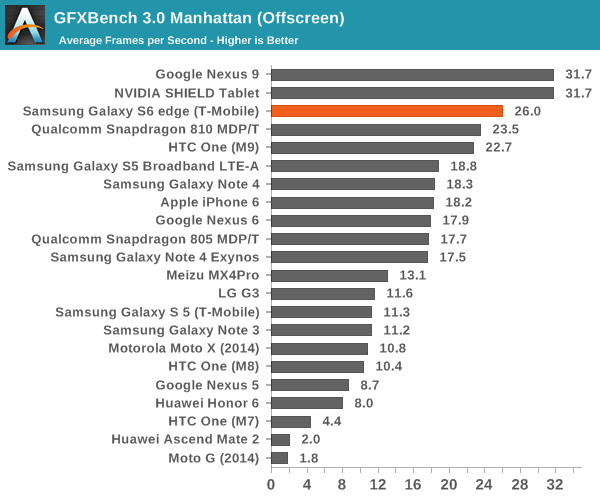
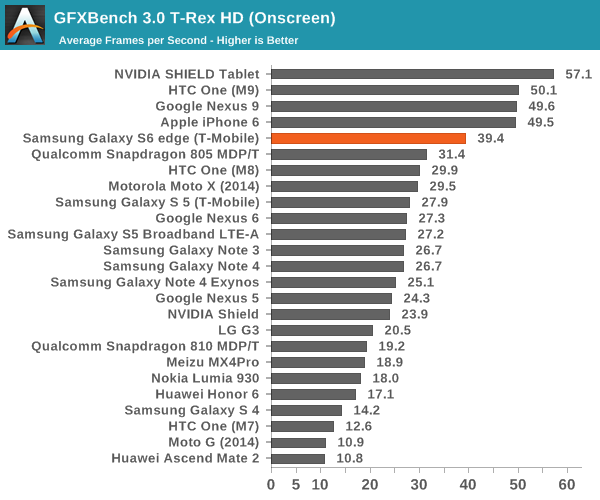
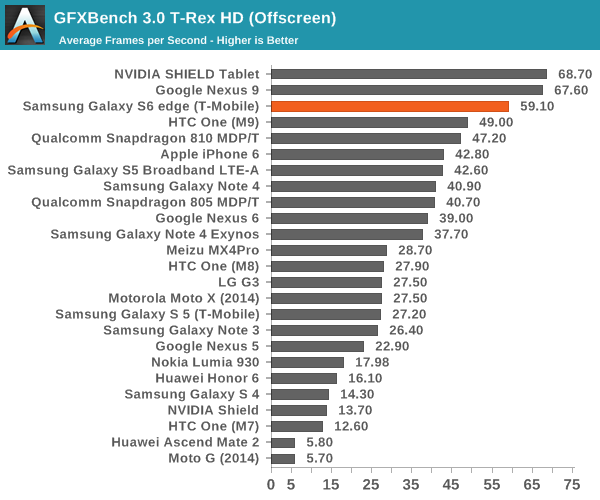
From the results the Mali T760MP8 GPU of the Exynos 7420 performs admirably in comparison to the Adreno 430 of the Snapdragon 810. We see a 10% lead over the Adreno 430 in Manhattan, growing to 20% in T-Rex. Qualcomm hinted that the Adreno 430 is more strongly improved in ALU performance over the Adreno 420, which would explain why the gap isn't as significant this generation. A 700 MHz clock on the Adreno 430 would likely equal to T760 in this case, but I suspect the power consumption of such a clock would be untenable. The Galaxy S6 does fall behind on the on-screen benchmarks due to the 1440p display compared to the 1080p display of the One M9, but rendering at a lower resolution would avoid most of these problems in real games.
Display
As previously discussed, the Galaxy S6 line introduces a newer generation of AMOLED displays, which is said to increase maximum luminance to 600 nits. Samsung claims that this was achieved with the use of new materials, which is likely necessary in order to sustain power efficiency improvements. It doesn't seem that AMOLED is uniquely suited to high resolution, but rather that Samsung Display Corp. is managing to dramatically improve how they make AMOLED displays with every year that offset power consumption increases from higher resolution displays. To find out how Samsung did, we use SpectraCal's CalMAN 5 Ultimate, in addition to X-Rite's i1Pro2 Basic to characterize displays as accurately as possible.
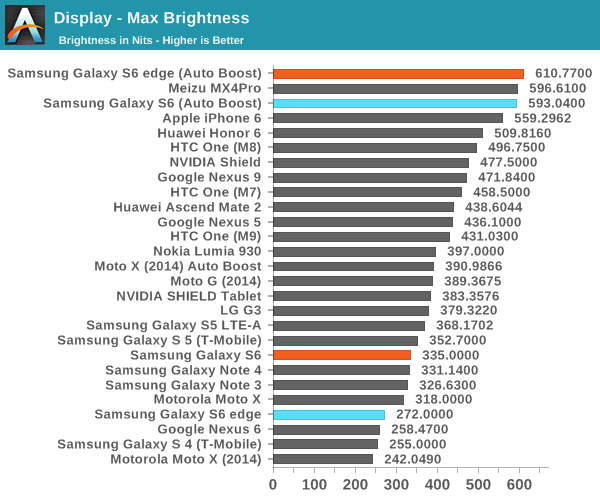
From the results Samsung's claims of a 600 nit display are valid in this case, which is a 100% APL white display. It's important to note that achieving this requires the use of auto-brightness, and that manual brightness is limited to a much lower brightness to reduce power usage, here the S6 sees similar maximum brightness as the S5. The S6 edge disappointingly only achieves 272 nits in this mode, a rather low value. I saw color balance shift dramatically in auto-boost mode, which suggests that this operating mode is likely less efficient than manual brightness. As an explanation, we've seen that colors are controlled in AMOLED by voltage while brightness is controlled by PWM (pulse width modulation). As with most recent AMOLED displays, there's no DC bias to the pixels so the contrast really is infinite instead of just a very large number when displaying black.
Galaxy S6
Galaxy S6 edge
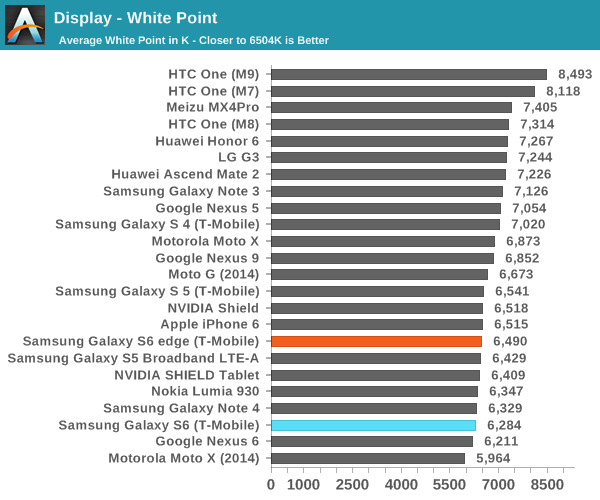
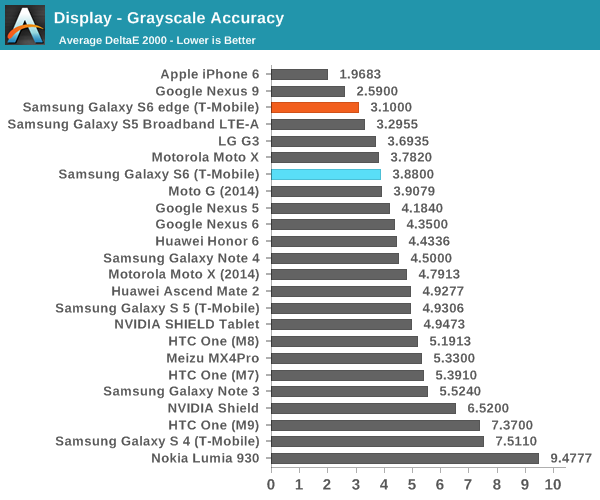
Moving on to grayscale, we can see that Samsung has done a pretty good job of controlling the white point and gamma across the saturation sweep, even if green is slightly dominant in both displays. We can also see that there is variation across displays as the S6 edge is closer to neutral while the S6 sample tends a bit warmer.
Galaxy S6
Galaxy S6 Edge
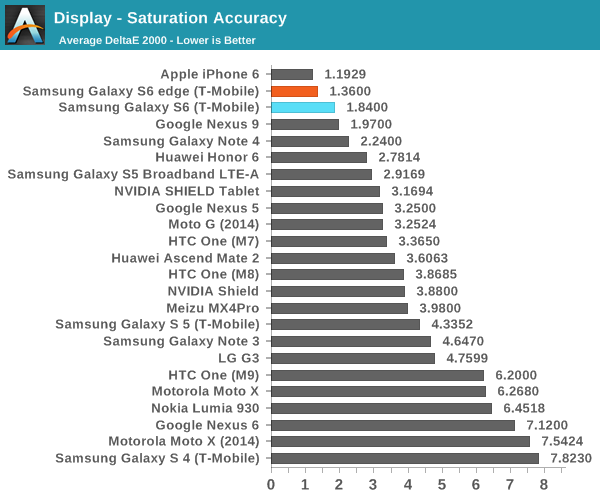
In the saturation sweep, both displays do an incredible job. I really don't have anything else to say here, because there's really no way to improve on the level of calibration Samsung has done on this display. Unless Samsung calibrates every single display in production, which is wildly impractical and effectively impossible to do, this is as good as it gets for a mass-produced device. Improving past this point will also be incredibly difficult to perceive, which means there's no real reason to go any further.
Galaxy S6
Galaxy S6 edge
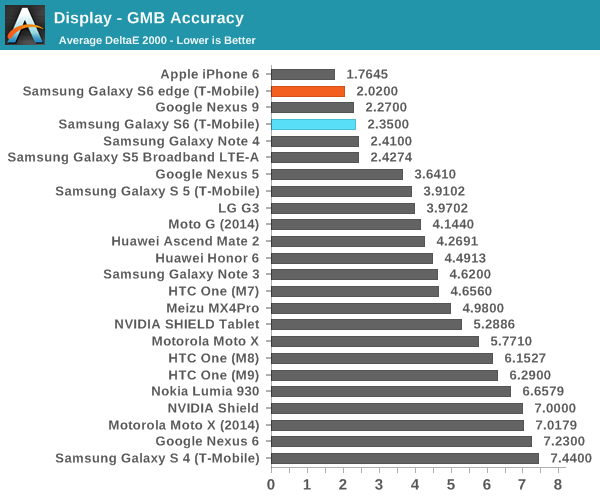
In the Gretag MacBeth ColorChecker, we can get an idea for overall color accuracy, which paints a picture similar to the saturation test. The only real problem I've noticed with these displays are the viewing angles, which can produce color shifting when the display is tilted. This is a bit of an issue on the edge variant as I can see that the edges of the display appear somewhat green when viewed head on, but otherwise there are no real issues to be seen here. Overall, this is probably the best display anyone will be able to get in a smartphone right now. This level of progress is amazing from Samsung, given just how bad things were with the Galaxy S' AMOLED display, even as recent as the display of the Galaxy S4. With the Galaxy S5 review, I said that I wouldn't be surprised to see AMOLED equal, if not exceed LCD within a year or two, and Samsung has managed to finally hit that mark.



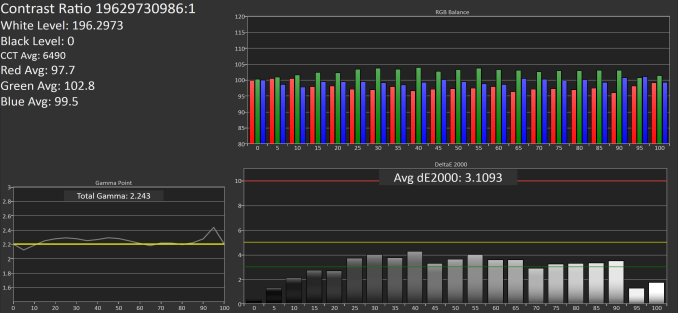
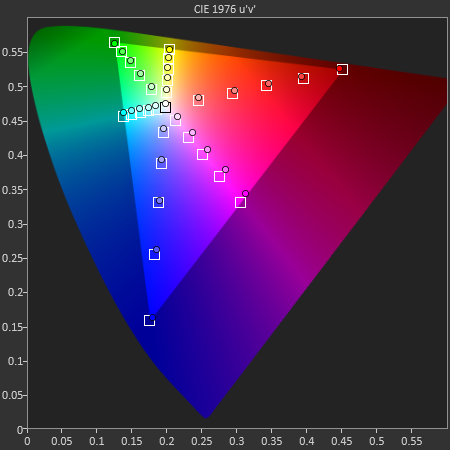
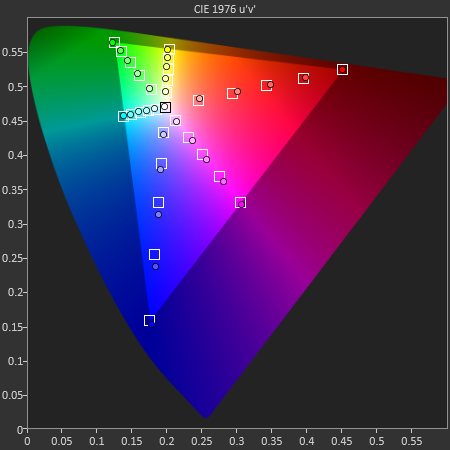
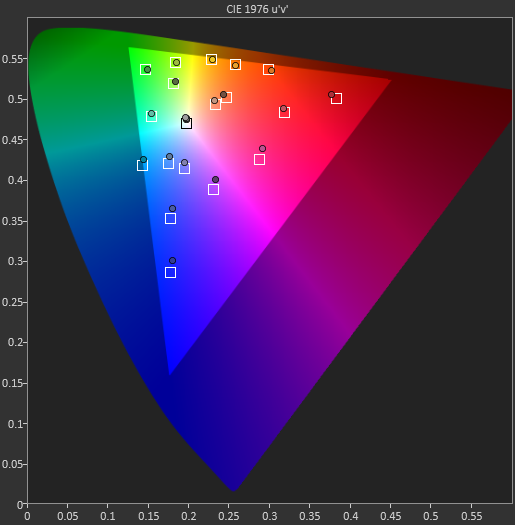









200 Comments
View All Comments
tommo123 - Saturday, March 28, 2015 - link
no removable storage - stopped reading.maybe the next note will be worth a look
MercuryHero - Tuesday, April 14, 2015 - link
The benefit is that the in-built storage would be faster and more efficient than MicroSD would be, however it's disappointing how much the price premium is for the larger 64GB/128GB models.csavage - Monday, March 30, 2015 - link
Bought the sector 5 element case for a friend's birthday, about 2 months later he asked me for the reciept because the corner piece broke. I gave it to him and he contacted the company, they were not helpful at all and told him he would need to order a new piece to fix the case. He was then able to fix on his own and broke again within the first year. $140 dollars for a case should be under warranty for life, lets be honest most people have a phone for 2 years and would need a new case.very dissapointing cheap product waste of money...........
AnnonymousCoward - Monday, March 30, 2015 - link
Go whine somewhere else.very disappointing post waste of time..........
nathan119 - Monday, March 30, 2015 - link
Obviously those of you coming from an S5 or other galaxy phone with replaceable battery and microsd are miffed, but there are a lot of us that have been living without those features for a while. I haven't had those features since my Galaxy Nexus, but since then it's been the Nexus 4 and 5, and it honestly hasn't been a problem for me.I stream pretty much all my music, so even a 16gb nexus device has been fine. A 32gb Galaxy S6 would be plenty.
But as a loyal Nexus user, I find myself drawn to the S6 for a couple reasons. The Nexus 6 is just flat out too big, and with nothing in the 5" range on the horizon, what is a loyal Nexus user to do?
Couple things about the S6 have me interested. Awesome display. Awesome camera. In fact, as a Nexus faithful...having an awesome camera would be amazing, and by all accounts, this is one of the best around. Battery life also looks better than my Nexus 4 or 5, so even if it is smaller than last year, it's still a big upgrade for me.
And really, there aren't a lot of phones to consider. HTC is out, because the camera sucks. Note 4 and Nexus 6 are too big. One plus one...bad support, bad screen. So for everyone complaining about the lack of removable battery and microsd....what exactly are you moving to?
Kidster3001 - Wednesday, April 1, 2015 - link
Why, oh why, do you still use browsers to test CPU performance???? You are just testing the efficiency and optimization of the browser. Put an old version of Chrome on your Nexus 9 and see how well it does.... and comparing any browser on an Apple device against any browser on an Android device is just plain misleading.MercuryHero - Tuesday, April 14, 2015 - link
Obviously it doesn't make sense as a general measure of device performance or hardware performance, but browser speed is still an interesting comparison to make, as long as it's never claimed or inferred that it measures hardware or general device performance.jamesns - Thursday, April 2, 2015 - link
Brand New Unlocked Original Apple iphone 6 16gb, 64gb and 128GB , White , Black, Silver and GoldWhatsapp CHAT or Call : 00254703285513
Samsung Galaxy S6 edge and Samsung Galaxy S6 cost 500usd
Samsung galaxy s5 cost 400usd
Samsung note 4 cost 400usd
dummyaccount12345 - Saturday, April 11, 2015 - link
When is the full review coming out?!?!? Can't wait!anubis44 - Wednesday, April 15, 2015 - link
"and the result of this is a Galaxy phone that looks unlike anything else they’ve ever released."I beg to differ. The S6 looks exactly like the S4 to me. I wouldn't be able to tell the difference if my life depended on it. This is not a bad thing, however. Once a form factor is sufficiently refined, there shouldn't be any radical changes to the essential design. After all, human anatomy is the target, and human anatomy doesn't change over years or decades, so why should the product's essential egonomics, once they're pretty well perfect? Our ears, hands, and eyes aren't going to get bigger or smaller, so once the product is optimized for most people's ears, hands and eyes, radical changes to dimensions would be stupid, especially if you hope to be able to use the device in the same way, i.e. to be able to show others what you're looking at, to use as a telephone without a wireless earpiece, have a type-able keyboard, so you don't have to shout at the phone to try to do voice recognition, etc.